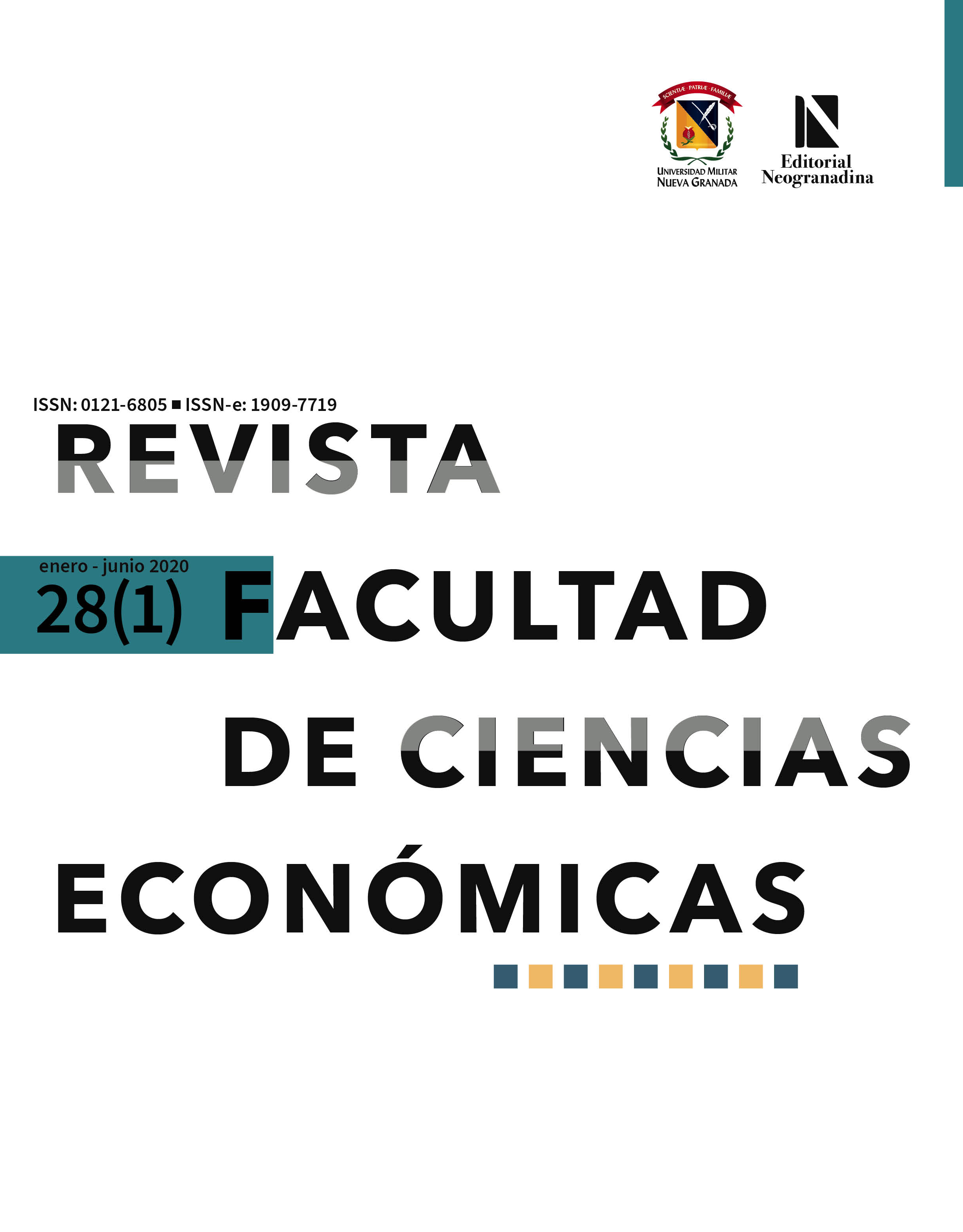Comportamiento de los agentes en el comercio electrónico según modelos de localización
Resumen
Dentro del amplio espectro de la utilización de la Teoría de Juegos en la actividad económica, de entre sus muchas aplicaciones teóricas y empíricas concernientes a la toma de decisiones empresariales en forma de juegos, resaltamos aquella que tiene por objeto de estudio entender las relaciones entre las empresas en un contexto microeconómico. Específicamente, en el contexto del comercio electrónico, que actualmente ha alcanzado un nivel de inserción muy importante y diverso en todos los sectores. El presente artículo es el resultado de una investigación exploratoria en tres fases donde, por medio de la metodología de investigación de acción participativa, se logra una contrastación del modelo de Ciudad Circular, propuesto por Salop en 1979, en el contexto de los negocios electrónicos, específicamente en eBay.
Descargas
Referencias bibliográficas
Abrams, P. y Rueffler, C. y Dinnage, R. (2008). Competition-Similarity Relationships and the Nonlinearity of Competitive Effects in Consumer-Resource Systems. The American Naturalist, 172(4), 463-474. doi: https://doi.org/10.1086/590963
Agarwal, R. y Ergun, O (2010) Network Design and Allocation Mechanisms for Carrier Alliances in Liner Shipping. Operations Research, Informs, 58(6), 1726-1742. doi: https://doi.org/10.1287/opre.1100.0848
Aghion, P. y Holder, R. (2001). Incomplete contracts and the theory of the firm: What have we learned over the past 25 years? Journal of Economic Perspectives, 25(2), 181-197. doi: https://doi.org/10.1257/jep.25.2.181
Ahuja, M. y Carley, Ka. (1999). Network Structure in Virtual Organizations. Organization Science, 10(6), 741- 757. doi: https://doi.org/10.1287/orsc.10.6.741
Akerlof, G. (1970). The market for ‘lemons’: Quality uncertainty and the market mechanism. Quarterly Journal of Economics, 84(3), 488-500. doi: https://doi.org/10.2307/1879431
Anumba, C. J. y Ruikar, K. (2008). E-business in Construction. Oxford: UK. Wiley-Blackwell. Ltd. eBook. doi: https://doi.org/10.1002/9781444302462
Archibald, G.C. y Rosenbluth, G. (1975). The New Theory of Consumer Demand and Monopolistic Competition. Quaterly Journal of Economics, 89, 569-590. doi: https://doi.org/10.2307/1884693
Aumann, R. J. (2017). Game theory. The New Palgrave Dictionary of Economics, 3, 1-40. Recuperado de https://link.springer.com/referenceworkentry/10.1057%2F978-1-349-95121-5_942-2
Azar, O. H. (2019). The influence of psychological game theory. Journal of Economic Behavior & Organization. 167, 445-453. doi: https://doi.org/10.1016/j.jebo.2018.09.009
Banerjee, P., Wei, K.K. y Ma, Louis. (2012). Role of trialability in b2b e-business. Behaviour & Information Technology. 31(9), 815-827. doi: https://doi.org/10.1080/0144929X.2010.497564
Bauner, C. (2015). Mechanism choice and the buy-it-now auction: A structural model of competing buyers and sellers. International Journal of Industrial Organization, 38, 19-31. doi: https://doi.org/10.1016/j.ijindorg.2014.12.001
Beeler, G. (2008). How Does Ideology Matter in the Spatial Model of Voting? Public Choice, 135(3/4), 109-123. doi: https://doi.org/10.1007/s11127-007-9241-2
Bicchieri, G. y Antonelli, G. A. (1995). Game-Theoretic Axioms for Local Rationality and Bounded Knowledge. Journal of Logic, Language, and Information, 4(2), 145-167. doi: https://doi.org/10.1007/BF01048618
Bleecker, S. (1994). The virtual organization. Futurist, 28(2), 9-14.
Bonanno, G. (1987). Location Choice, Product Proliferation and Entry Deterrence. The Review of Economic Studies, 54(1), 37-45. doi: https://doi.org/10.2307/2297444
Brams, S. (2011). Game Theory and the Humanities: Bridging Two Worlds. The mit Press (EBook). doi: https://doi.org/10.7551/mitpress/9780262015226.001.0001
Bronson, A. (2008). A Generalization of the Hotelling--Salop Model to M-dimensions. En Adams, J. Primaries and electoral strategies II. Midwest Political Science Association. 66th Annual National Conference. April 3-6. Chicago: usa.
Budler, M. y Trkman, P. (2017). The role of game theory in the development of business models in supply chains. En Technology & Engineering Management Conference (temscon), ieee, 155-159. doi: https://doi.org/10.1109/TEMSCON.2017.7998370
Campbell, J. (2011). Competition in large Markets. Journal of Applied Econometrics, 26(7), 1113-1136. doi: https://doi.org/10.1002/jae.1155
Chakrabarti, S. y Gilles, R. P. (2017). Partial Cooperation in Location Choice: Salop’s Model with Three Firms. En d’Amato, Mallozzi y Pardalos (eds.), Spatial Interaction Models pp. 21-38). Cham: Springer. doi: https://doi.org/10.1007/978-3-319-52654-6_2
Chamberlin, E. (1931). The Theory of Monopolistic Competition. Cambridge, Mass.: Harvard University Press.
Chang, K.P y Graham, G. (2012). E-Business Strategy in Supply Chain Collaboration: An Empirical Study of B2B E-Commerce Project in Taiwan. International Journal of Electronic Business Management, 10(2), 101-112.
Chen, C., Liu, H. y Guan, X. (2016). A Game Theory Based Model for Internet Public Opinion’s Embryonic Stage. Cybernetics and Information Technologies, 16(6), 43-59. doi: https://doi.org/10.1515/cait-2016-0076
Chen, K. P., Lai, H. P. y Yu, Y. T. (2018). The seller’s listing strategy in online auctions: Evidence from eBay. International Journal of Industrial Organization, 56, 107-144. doi: https://doi.org/10.1016/j.ijindorg.2017.11.003
Chein, I., Cook, S. W., y Harding, J. (1948). The Field of Action Research. American Psychologist, 3(2), 43–50. doi: https://doi.org/10.1037/h0053515
Choi, J. y Geistfeld, L. V. (2004) A cross-cultural investigation of consumer e-shopping adoption. Journal of Economic Psychology. 25(6), 821-838. doi: https://doi.org/10.1016/j.joep.2003.08.006
Colin, C. (1991). Does Strategy Need Game Theory? Strategic Management Journal, 12, Special Issue: Fundamental Research Issues in Strategy and Economics, 137-152. doi: https://doi.org/10.1002/smj.4250121010
Cominetti, R., Correa, J. y Stier-Moses, N. (2009). The Impact of Oligopolistic Competition in Networks. Operations Research, 57(6), 1421-1437. doi: https://doi.org/10.1287/opre.1080.0653
Compton, M. (2007). E-business, e-advancement, E-success. Women in Business. 59(5), 22-24.
Cowan, R. (1992). The Allocation of Offensive and Defensive Resources in a Territorial Game. Journal of Applied Probability, 29(1), 190-195. doi: https://doi.org/10.2307/3214803
Creth, S. (1995). Creating a virtual information organization. Educom Review. 30(2), 15-17.
Cunningham, J.B. (1983). Gathering Data in a Changing Organization. Human relations, 36(5), 403-420. doi: https://doi.org/10.1177/001872678303600501
Currie, W. (2004). Value Creation From E-business Models. Elsevier Butterworth Heinemann, eBook: https://doi.org/10.1016/B978-0-7506-6140-9.X5000-0
D’Aspremont, C., Gabszewics, J. y Thisse, J. (1979). On Hotelling’s Stability in Competition. Econometrica, 17, 1145-1150. doi: https://doi.org/10.2307/1911955
De Palma, A., Criado, C. O. y Randrianarisoa, L. M. (2018). When Hotelling meets Vickrey. Service timing and spatial asymmetry in the airline industry. Journal of Urban Economics, 105, 88-106. doi: https://doi.org/10.1016/j.jue.2018.01.003
Di Dio, F. y Correani, L. (2019). Collaboration Networks in a Hotelling Game. Economics Bulletin, 39(1), 127-141.
Edgeworth, F. (1881). Mathematical Psychics: An Essay on the Application of Mathematics to the Moral Sciences. London: Kegan Paul (reprinted New York: Augustus M. Kelley, 1967).
Farooqui, A. D. y Niazi, M. A. (2016). Game theory models for communication between agents: a review. Complex Adaptive Systems Modeling, 4(1), 1-13. doi: https://doi.org/10.1186/s40294-016-0026-7
Farquharson, R. (1969). Theory of Voting. Blackwell: Yale University Press.
Galbreth, M., March, S., Scudder, G. y Shor, M. (2005). A Game-Theoretic Model of E-Marketplace Participation Growth. Journal of Management Information Systems. 22(1), 295-319. doi: https://doi.org/10.1080/07421222.2003.11045837
Gale, D. y Shapley, LL. (1962). College admissions and the stability of marriage. American Mathematics Monthly, 69, 9-15. doi: https://doi.org/10.1080/00029890.1962.11989827
Galeotti, A., Goyal, S., Jackson, M., Vega-Redondo, F. y Yariv, L. (2010). Network Games. The Review of Economic Studies, 77(1), 218-244. doi: https://doi.org/10.1111/j.1467-937X.2009.00570.x
Gao, J. y You, F. (2018). A Game Theory Approach to Design and Optimization of Decentralized Supply Chains under Uncertainty. Computer Aided Chemical Engineering, 44, 1603-1608. doi: https://doi.org/10.1016/B978-0-444-64241-7.50262-7
Gaudet, G. (2007). Natural Resource Economics under the Rule of Hotelling. The Canadian Journal of Economics, 40(4), 1033-1059. doi: https://doi.org/10.1111/j.1365-2966.2007.00441.x
Gaudeul, A. y Sugden, R. (2012). Spurious Complexity and Common Standards in Markets for Consumer Goods. Economica, 79(314), 209-225. doi: https://doi.org/10.1111/j.1468-0335.2011.00895.x
Geisler, M. y Wiese, H. (2006). Entry deterrence in the Schmalensee-Salop Model. Applied Economics Letters, 13, 127–130. doi: https://doi.org/10.1080/13504850500392131
Goeschl, T. y Camargo, D. (2004). Reconciling Conservation and Development: A Dynamic Hotelling Model of Extractive Reserves. Land Economics, 80(3), 340-354. doi: https://doi.org/10.2307/3654725
González-Campo, C. (2005). El Cliente: ¿un elemento del sistema? Una aplicación de la Teoría General de Sistemas en los Negocios Electrónicos. Libre Empresa. 2(2). 59-74.
González-Campo, C. (2010). E-Stakeholders: una aplicación de la teoría de los stakeholder a los negocios electrónicos. Estudios Gerenciales. 26(114), 39-57. doi: https://doi.org/10.1016/S0123-5923(10)70101-7
Gray, R. y Malla, S. (2011). Managing Public ip with Downstream Interfirm Research Spillovers. Canadian Journal of Agricultural Economics, 59, 475–491.
doi: https://doi.org/10.1111/j.1744-7976.2011.01224.x
Grebe, T., Ivanova-Stenzel, R. y Kröger, S. (2018). How Do Sellers Benefit From Buy-It-Now Prices in Ebay Auctions? An Experimental Investigation. Rationality & competition, 97. Recuperado de en https://rationality-and-competition.de/wp-content/uploads/discussion_paper/97.pdf.
Han, J., Qiu, C. y Popkowski Leszczyc, P. (2018). The effects of competitive reserve prices in online auctions. European Journal of Marketing, 52(7/8), 1439-1456. doi: https://doi.org/10.1108/EJM-10-2017-0684
Handy, C. (1995). Trust and the Virtual Organization. Harvard Business Review, 73(3), 40-50.
Harsanyi, J. (1959). A bargaining model for the cooperative game. En AW Tucker and RD Luce (eds.), Contributions to the Theory of Games, 4 (pp. 324–356).
Princeton, NJ: Princeton University Press. doi: https://doi.org/10.1515/9781400882168-019
He, P., Zhang, S. y He, C. (2019). Impacts of Logistics Resource Sharing on b2b E-commerce Companies and Consumers. Electronic Commerce Research and Applications, 34, 100820. doi: 10.1016/j.elerap.2018.100820
Hernández, M. (2011). Nonlinear pricing and competition intensity in a Hotelling-type model with discrete product and consumer types. Economics Letters, 110, 174-177. doi: https://doi.org/10.1016/j.econlet.2010.11.031
Hoppe, H. y Lehmann-Grube, U. (2008). Price Competition in Markets with Customer Testing: The Captive Customer Effect. Economic Theory, 35(3), 497-521. doi: https://doi.org/10.1007/s00199-007-0250-7
Hotelling, H. (1929). Stability in Competition. The Economic Journal, 39(153), 41-57. doi: https://doi.org/10.2307/2224214
Hu, Y. y Tang, M. (2014) Game Theory Analysis of E-Commerce’s Price War. iBusiness, 6, 189-194. doi: https://doi.org/10.4236/ib.2014.64019
Ireland, N. (1989). Product Differentiation and Non-Price Competition, Oxford: North Holland.
Isaacs, R. (1999). Differential Games: A Mathematical Theory with Applications to Warfare and Pursuit, Control and Optimization. New York: Dover Publications.
Jay, P. y Byung-Cheol, K. (2010). Net neutrality and investment incentives. The rand Journal of Economics, 41(3), 446-471. doi: https://doi.org/10.1111/j.1756-2171.2010.00107.x
Jianya, Z., Weigang, L. y Li, D. L. (2015, April). A Game-theory based Model for Analyzing E-marketplace Competition. En Hammoundi, Maciaszek, Teniente (eds.), iceis 2015: Proceedings of the 17th International Conference on Enterprise Information Systems. 1 (pp. 650-657). Portugal, Setúbal: SCITEPRESS-Science and Technology Publications, Lda. doi: https://doi.org/10.5220/0005467706500657
Kaldor, N. (1935). Market Imperfection and Excess Capacity. Economica NS, 2(5), 33-50. doi: https://doi.org/10.2307/2549105
Katona, Z. y Sarvary, M. (2008). Network Formation and the Structure of the Commercial World Wide Web. Marketing Science, 27(5), 764-778. doi: https://doi.org/10.1287/mksc.1070.0349
Kitahara, M. y Matsumura, T. (2006). Tax Effects in a Model of Product Differentiation: A Note. Journal of Economics, 89(1), 75–82. doi: https://doi.org/10.1007/s00712-006-0180-z
Kurland, N. y Egan, T. (1999). Telecommuting: Justice and Control in the Virtual Organization. Organization Science, 10(4), 500-513. doi: https://doi.org/10.1287/orsc.10.4.500
Kuruzovich, J. y Etzion, H. (2018). Online Auctions and Multichannel Retailing. Management Science, 64(6), 2734-2753. doi: https://doi.org/10.1287/mnsc.2017.2732
Leonard, R. (2006). Theory of Games and Economic Behavior. History of Political Economy. 38(1), 189-190. doi: https://doi.org/10.1215/00182702-38-1-189
Lerner, A. y Singer, H.W. (1937). Some Notes on Duopoly and Spatial Competition. Journal of Political Economy, 45, 145-186. doi: https://doi.org/10.1086/255039
Lewin, K. (1946) Action Research and Minority Problems. Journal for Social Issues, 2(4), 34-46. doi: https://doi.org/10.1111/j.1540-4560.1946.tb02295.x
Li, Y (2018) The Strategic Decision on Mobile Payment: A Study on Merchants’ Adoption. Proc. 24th Americas Conference on Information Systems (AMCIS). New Orleans, LA, EEUU. 1-4
Liu, D., Xun, L. y Santhanam, R. (2013). Digital Games and Beyond: What Happens when Players Compete? mis Quarterly. 37(1), 111-124. doi: https://doi.org/10.25300/MISQ/2013/37.1.05
Liu, M. (2017). Solutions to E-commerce Marketing Channels in Mobile Communication Industry. Revista de la Facultad de Ingeniería, 32(13), 460-464. doi: https://doi.org/10.25300/MISQ/2013/37.1.05
Malhotra, D. (2005). Decision Making Using Game Theory: An Introduction for Managers. Academy of Management Review, 30(1), 193-194. doi: https://doi.org/10.5465/amr.2005.15281461
Marden, J. R. y Shamma, J. S. (2018). Game Theory and Control. Annual Review of Control, Robotics, and Autonomous Systems, 1, 105-134. doi: https://doi.org/10.1146/annurev-control-060117-105102
Matsumura, T. (2005). Competition-accelerating public investments. Australian Economic Papers, 44(3), 269-274. doi: https://doi.org/10.1111/j.1467-8454.2005.00264.x
Matsumura, T. y Matsushima, N. (2004). Endogenous Cost Differentials between Public and Private Enterprises: A Mixed Duopoly Approach. Economica, (71), 671–688. doi: https://doi.org/10.1111/j.0013- 0427.2004.00394.x
Mctaggart, R. (1991) Principles for Paticipatory Action Research. Adult education quartely. 41(3), 168-187. doi: https://doi.org/10.1177/0001848191041003003
Meagher, K. y Zauner, K. (2005). Location-Then-Price Competition with Uncertain Consumer Tastes. Economic Theory, 25(4), 799-818. doi: https://doi.org/10.1007/s00199-004-0520-6
Middleton, J. (2006). Gurus on E-business. Londres: Thorogood Publishing, eBook.
Milutinovie, V. y Patricelli, F. (2002). E-business and E-challenges. Emerging communication, 4, 1566-7677.
Montgomery, J. (2007). Beyond Individual Choice: Teams and Frames in Game Theory. American Journal of Sociology. 113(3), 883-886. doi: https://doi.org/10.1086/524790
Morais, E., Pires, P. y Goncalves, J. (2012). E-Business Maturity: Constraints Associated with Their Evolution. Journal of Organizational Computing & Electronic Commerce. 22(3), 280-300. doi: https://doi.org/10.1080/10919392.2012.696952
Murphy, P. (2017). Game theory as a paradigm for the public relations process. Public relations theory, 173- 192.
Muthitacharoen, A. y Tams, S. (2017) The Role of Auction Duration in Bidder Strategies and Auction Prices. International Journal of Electronic Commerce, 21(1), 67-98 https://doi.org/10.1080/10864415.2016.1204190
Nash, J. (1950). The Bargaining Problem. Econometrica, 18, 155-162. doi: https://doi.org/10.2307/1907266
Nash, J. (1951). Non-cooperative games. Annals of Mathematics, 54, 286–295. doi: https://doi.org/10.2307/1969529
Neil, C. y Yong-Sook, L. (2006). The Strategic Localization of Transnational Retailers: The Case of Samsung-Tesco in South Korea. Economic Geography, 82(1), 61- 88. doi: https://doi.org/10.1111/j.1944-8287.2006.tb00288.x
Neogy, S. K., Bapat, R. B., Das, A. K. y Pradhan, B. (2016). Optimization models with economic and game theoretic applications. Annals of Operations Research, 243(1-2), 1-3. doi: https://doi.org/10.1007/s10479-016-2250-0
Nishino, N. y Okuda, K. (2016). Business Structure of e-Book Service as a Product Service System: A Game Theoretic Approach. En Maeno, Yuriko, Tatsunori, Serviceology for Designing the Future: Selected an Edited Papers of the 2nd International Conference on Serviceology (pp. 125-144), Tokyo: Springer. doi: https://doi.org/10.1007/978-4-431-55861-3_9
Niyato, D., Lu, X., Wang, P., Kim, D. I. y Han, Z. (2016). Economics of Internet of Things: An information market approach. ieee Wireless Communications, 23(4), 136-145. doi: https://doi.org/10.1109/MWC.2016.7553037
Pagnozzi, M. y Piccolo, S. (2012). Vertical separation with private contracts. The Economic Journal, 122(559), 173-207. doi: https://doi.org/10.1111/j.1468-0297.2011.02471.x
Peeters, R., Strobel, M., Vermeulen, D. y Walzl, M. (2016). The Impact of the Irrelevant: Temporary Buy-Options and Bidding Behavior in Auctions. Games, 7(1), 8. doi: https://doi.org/10.3390/g7010008
Prescott, E. y Visscher, M. (1977) Sequential Location among Firms with Foresight. Bell Journal of Economics, 8(2), 378-393. https://doi.org/10.2307/3003293
Princely, I. (2011). An Empirical Analysis of Factors Influencing Internet/e-business Technologies Adoption by smes in Canada. International Journal of Information Technology & Decision Making, 10(4), 731-766. doi: https://doi.org/10.1142/S0219622011004543
Renna, P. y Argoneto, P. (2010) A game theoretic coordination for trading capacity in multisite factory environment. The International Journal of Advanced Manufacturing Technology. 47, 1241–1252. https://doi.org/10.1007/s00170-009-2254-x
Rodríguez, G. (2012). Sequential Auctions with Imperfect Quantity Commitment. Economic Theory, 49(1), 143-173. doi: https://doi.org/10.1007/s00199-010-0545-y
Salanié, B. (1997). The Economics of Contracts. Cambridge, London: mit Press.
Saloner, G. (1991). Modeling, Game Theory, and Strategic Management. Strategic Management Journal, 12, número especial: Fundamental Research Issues in Strategy and Economics, 119-136. doi: https://doi.org/10.1002/smj.4250121009
Salop, S. (1979). Monopolistic Competition with Outside Goods. The Bell Journal of Economics, 10(1), 141-156. doi: https://doi.org/10.2307/3003323
Sarmiento C. y Wilson, W. (2005). Spatial Modeling in Technology Adoption Decisions: The Case of Shuttle Train Elevators. American Journal of Agricultural Economics, 87(4), 1034-1045. doi:
https://doi.org/10.1111/j.1467-8276.2005.00786.x
Schmalensee, R. (1978). Entry Deterrence in the Ready-to-Eat Breakfast Cereal Industry. The Bell Journal of Economics, 9, 305-327. doi: https://doi.org/10.2307/3003584
Schmitt, N. (1995). Product Imitation, Product Differentiation and International. Trade International Economic Review, 36(3), 583-608. doi: https://doi.org/10.2307/2527362
Shapley, Ll. (1952). N-Person games —Stable-set Solutions Including an Arbitrary Closed Component. Rand Corporation, Santa Monica, CA, usa. Recuperado de https://www.rand.org/pubs/research_memoranda/RM1005.htm.
Shapley, Ll. (1953). A Value for n-person Games. En: HW Kuhn y AW Tucker (eds.), Contributions to the Theory of Games, Vol. 2 (pp. 307-317). Princeton: Princeton University Press. doi: https://doi.org/10.1515/9781400881970-018
Shapley, Ll. y Shubik, M. (1954). A Method for Evaluating the Distribution of Power in a Committee System. American Political Science Review, 48(3), 787-792. doi: https://doi.org/10.2307/1951053
Shapley, Ll. y Shubik, M. (1971). The Assignment Game I: The core. International Journal of Game Theory, 1, 111-130. doi: https://doi.org/10.1007/BF01753437
Sharma, V. (2013). Enhancement of Trust in the Export Management Company-supplier Relationship through e-business. International Journal of Commerce & Management. 23(1), 24-37. doi: https://doi.org/10.1108/10569211311311131
Shubik, M. (1959). Strategy and Market Structure. New York: Wiley.
Shubik, M. (1970). Budgets in a Decentralized Organization with Incomplete Information. Rand Corporation, Santa Monica, CA, usa.
Simonsohn, U. (2010). EBay’s Crowded Evenings: Competition Neglect in Market Entry Decisions. Management Science, 56(7), 1060-1073. doi: https://doi.org/10.1287/mnsc.1100.1180
Sridhar, M. (1985). Using Game Theory to Model Competition. Journal of Marketing Research, 22(3), 262-282. doi: https://doi.org/10.1177/002224378502200303
Tadelis, S. (2016). Reputation and Feedback Systems in Online Platform Markets. Annual Review of Economics, 8, 321-340. doi: https://doi.org/10.1146/annurev-economics-080315-015325
Thomas, M. Wirtz, B. y Weyerer, J. (2019) Determinants of Online Review Credibility and Its Impact on Consumers’ Purchase Intention. Journal of Electronic Commerce Research, 20(1), 1-21.
Tirole, J. (1988). The Theory of industrial Organization, Cambridge: mit Press.
Tolotti, M. y Yépez, J. (2018). Hotelling-Bertrand Duopoly Competition Under Firm-Specific Network Effects. Recuperado de https://papers.ssrn.com/sol3/papers.cfm?abstract_id=3209218. doi: https://doi.org/10.2139/ssrn.3209218
Von Neumann, J. y Morgenstern, O. (1944). Theory of Games and Economic Behavior, Princeton, NJ: Princeton University Press.
Wenzel, T. (2011). Deregulation of Shopping Hours: The Impact on Independent Retailers and Chain Stores. The Scandinavian Journal of Economics, 113(1), 145–166. doi: https://doi.org/10.1111/j.1467-9442.2010.01636.x
Whitford, A. (2005). Introducing Game Theory and Its Applications. Interfaces, 35(5), 437-439.
Xu, J. y Quaddus, M.A. (2010). “E-business in the 21st Century: Realities, Challenges, and Outlook”. En: Solanas, Martínez y Rovira (eds.), Intelligent Information Systems (pp. 3-34), v. 2, Singapore: World Scientific Publishing Co. doi: https://doi.org/10.1142/7097
Yao, J. y Ansari, N. (2018). Caching in Energy Harvesting Aided Internet of Things: A Game-Theoretic Approach. ieee Internet of Things Journal, 6(2), 3194-3201. DOI: 10.1109/jiot.2018.2880483. doi: https:// doi.org/10.1109/JIOT.2018.2880483
Zhao, M. y Xia, Y. (2017) Analysis of Port Pricing Based on Circle Model. 4th International Conference on Industrial Economics System and Industrial Security Engineering (ieis), Kyoto, 1-6. doi: https://doi.org/10.1109/IEIS42702.2017
Zhang, X., Zhou, Y. y Han, Q. (2019). Game Theory-based Environmental lcc Control Behavior Analysis. Journal of Cleaner Production, 211, 1527-1533. doi: https://doi.org/10.1016/j.jclepro.2018.11.237
Zhou, J. y Fan, T. (2015). Research on the Competition Strategy of the Fresh Agricultural Products based on Hotelling Model. International Conference on Logistics Engineering, Management and Computer Science. doi: https://doi.org/10.2991/lemcs-15.2015.249
Zhu, K. (2004). Information Transparency of Business-to-Business Electronic Markets: A Game-Theoretic Analysis. Management Science, 50(5), 670–685. doi: https://doi.org/10.1287/mnsc.1040.0226
Zomorrodi, A. R. y Segrè, D. (2017). Genome-driven evolutionary game theory helps understand the rise of metabolic interdependencies in microbial communities. Nature Communications, 8(1), 1563. doi: https://doi.org/10.1038/s41467-017-01407-5












